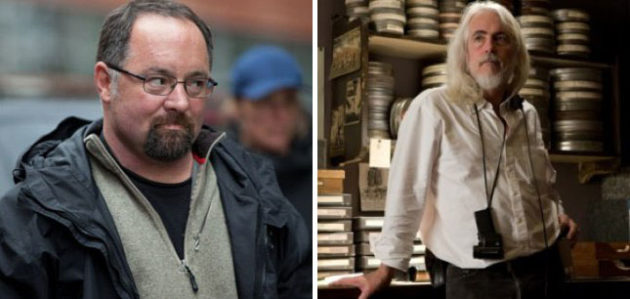Oscar Chat: A Conversation With Best Cinematography Nominees Jeff Cronenweth and Robert Richardson

The films almost couldn’t be more different: Hugo is an epic, 3-D family film that wraps us up in a warm glow, and The Girl With the Dragon Tattoo is a chilling murder mystery set in the stifling Nordic winter. Robert Richardson and Jeff Cronenweth — the cinematographers (pictured above R-L) tasked with making these respective worlds believable — will contend this weekend for an Oscar for Best Cinematography (along with The Artist's Guillaume Schiffman, The Tree of Life's Emmanuel Lubezki and War Horse's Janusz Kaminski). Movieline spoke with Cronenweth and Richardson about their approach and style on their nominated films as well as their recognition from the Academy.
What did the narrative of this film demand of you in terms of style?
CRONENWETH: A murder mystery in and of itself has its own set of dramatic license and techniques to implore. But with Dragon Tattoo being the first book of the incredibly detailed Stieg Larsson trilogy and set in the Swedish countryside during a particularly harsh winter, we inherited certain esthetic obligations, the most obvious one being the cold and how it affects the lives of our characters. It was imperative that we afforded the audience to appreciate that visually through quality and color of light and through sound effects.
RICHARDSON: The narrative of Hugo slipped from the seed of Brian Selznick's illustrations — in that respect all departments enhanced the reality of the world that Hugo lived within — that became the foundation of our style.
How much did you collaborate with your director on the message of each scene?
CRONENWETH: Well, there is always a conversation about the impetus of each scene and the purpose of each shot within that scene. Then on the shoot day, when we actually rehearse with the cast and block the scene, we apply those discussions but stay open to discovery.
RICHARDSON: Communication with Marty [Scorsese] is extremely specific — there is not a shot within his storyboards that does not have a purpose — in the same light his concept of what each scenes "message" might be is a reflection of this degree of precision — in respect to collaboration — generally it is less about collaboration of origin of concept and more about collaborating on manner and methods of achievement of his vision.
This year, there's a mix of digital and film among the nominees for Best Cinematography. How much does shooting on film vs. digital matter to you?
CRONENWETH: I still like the notion that some formats support certain stories better than others, and I like the idea that we are afforded the luxury of different story telling tools. But having said that I feel the gap between the two has closed for all intents and purposes.
RICHARDSON: Digital capture and film capture both have their advantages and disadvantages. I shot Hugo on digital with the Alexa and am now in the process of shooting Django Unchained on 35mm anamorphic. I feel comfortable with either digital or film — the director and the project should determine the course of choice.
Does this digital-film diversity among cinematographers make it a more exciting race, and how so?
CRONENWETH: I think the drastically different subject matter and story styles are a more interesting conversation than the digital vs. film. Black-and-white silent-period movie, a 3-D children's fairy tale colorful and dramatic, WWII fantasy about a horse beautifully epic and classic, a story of life shot free-flowing with available light crosscut with nature's marvels, and a murder mystery set in the Swedish country in the middle of winter.
RICHARDSON: I am uncertain about this question. The product should speak for itself. I sense that perhaps you are making too much of too little. In the end (I believe) not one of the projects is not in some manner a digital collaboration — the digital intermediate currently is placed between capture and presentation — the number of screens with which to view a film capture and traditional chemical treatment is on a rapid decline — most presentations are now digital cinema and that percentage will rise exponentially — was The Artist shot on black and white? I am uncertain, but I would hazard the guess that it was shot on color film and then in post had the color removed, meaning regardless of capture most projects at some point become digitized. With that in mind I would ask if you might tell me where does digital and film begin and or end. Furthermore, what is the percentage of films that you have viewed this year that were captured on film, processed, printed for dailies and distributed on film to the cinema? Sadly, cinemas with film as the primary source are disappearing. We need to remain open to change. That does not require one to divorce the past but to respect and process both the present and the future.
Are there any colleagues you would've liked to see nominated for best cinematography this year?
CRONENWETH: Newton Thomas Sigel for Drive.
RICHARDSON: Far too many to list.
Who is accompanying you to the ceremony?
CRONENWETH: My beautiful girlfriend Tyne Doyle.
RICHARDSON: My wife, Stephanie Martin, will be accompanying me to the Oscars as she did to the BAFTAs.
How are you following this film? What is your next project?
CRONENWETH: Directing commercials at the moment and reading scripts.
RICHARDSON: I followed Hugo with World War Z (Marc Forster), and I am currently filming Django Unchained (Quentin Tarantino).
MORE 2012 OSCAR ROUNDTABLES & CHATS
Best Costume Design
Best Documentary Feature
Best Foreign-Language Feature

Comments
Yeah I m really enjoying the template theme of this blog and interesting news. Thank you for blogging